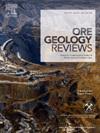Garnet U-Pb geochronology and geochemistry of the Pusangguo skarn deposit in Tibet: Insights into the genesis and fluid evolution during prograde skarn formation
IF 3.2
2区 地球科学
Q1 GEOLOGY
引用次数: 0
Abstract
The Pusangguo skarn deposit is located in the western part of the Gangdese metallogenic belt. Over the past few decades, the geology, petrogenesis, fluid inclusion and skarn mineralogy of this deposit have been studied in detail. However, there is still a lack of direct timing of the formation of the skarn at the Pusangguo deposit, which is critical to insight into the mineralization process. Two types of garnets were identified at the Pusangguo in this study, i.e., dark brown and coarse-grained garnet (Grt-1), and green to brown fine-grained garnet (Grt-2). At Pusangguo, the garnets mainly belong to andradite-grossular solid solution series. Grt-1 displays a more restricted composition range of Adr87.85–98.55Grs0–8.96, while the Grt-2 contains a broader range (Adr54.09–87.87Grs11.53–44.73). LA-ICP-MS U-Pb dating of Grt-1 and Grt-2 yielded lower intercept 206Pb/238U ages of 14.7 ± 2.2 Ma (n = 30, MSWD = 2.1) and 13.9 ± 1.3 Ma (n = 30, MSWD = 0.6), respectively, coeval with the ore formation and ore-related granodiorite. Grt-1 shows a slight enrichment in LREE and a depletion in HREE without apparent Eu anomalies, while Grt-2 exhibits an enrichment in LREE and a depletion in HREE with clear positive Eu anomalies. Correlations between ΣREE and Al, Fe3+, Fe2+, Mn2+, and Ca2+ together suggest that REE3+ incorporation into the Pusangguo garnet is most likely controlled by a coupled substitution mechanism related to Ca-site vacancies, and may also be influenced by external factors such as pH and oxygen fugacity (fO2). The positive correlation between ΣREE and Y implies that Y3+ and REE3+ have similar geochemical behavior. Grt-1 has higher ΣREE, HFSE, U and Y contents than Grt-2. We propose that Grt-1 is probably formed by self-organizing at a relatively low growth rate, resulting in fluid Al/Fe fluctuations associated with changing external factors such as fluid mixing. The distinct geochemical properties of Grt-1 and Grt-2 indicate that Grt-1 likely originated in a nearly neutral to slightly acidic and oxidized environment with a lower W/R ratio, while Grt-2 could have formed in a more acidic and relatively reducing condition with a higher W/R ratio. Changes in redox, pH and W/R ratios led to a shift in composition from Grt-1 to Grt-2 as the hydrothermal fluid ascended. As the fluid underwent crystallization, there was a decrease in fO2, resulting in a transition from a weakly acidic to a strongly acidic state. This change in fluid chemistry ultimately led to the precipitation of metal sulfides.

西藏普桑果矽卡岩矿床的石榴石U-Pb地质年代和地球化学:对矽卡岩顺层形成过程中的成因和流体演化的启示
普桑果矽卡岩矿床位于冈底斯成矿带西部。在过去的几十年里,人们对该矿床的地质、成岩、流体包裹体和矽卡岩矿物学进行了详细的研究。但是,仍然缺乏对普桑果矿床矽卡岩形成时间的直接研究,而这对深入了解矿化过程至关重要。本研究在普相国发现了两种类型的石榴石,即深棕色粗粒石榴石(Grt-1)和绿色至棕色细粒石榴石(Grt-2)。普桑果的石榴石主要属于安拉石-粗粒固溶体系列。Grt-1的成分范围较为有限,为Adr87.85-98.55Grs0-8.96,而Grt-2的成分范围较广(Adr54.09-87.87Grs11.53-44.73)。对Grt-1和Grt-2进行LA-ICP-MS U-Pb测年,得到的下截距206Pb/238U年龄分别为14.7±2.2Ma(n=30,MSWD=2.1)和13.9±1.3Ma(n=30,MSWD=0.6),与矿石形成和与矿石相关的花岗闪长岩为同一时代。Grt-1显示出LREE的轻微富集和HREE的贫化,但没有明显的Eu异常;而Grt-2则显示出LREE的富集和HREE的贫化,并有明显的Eu正异常。ΣREE与Al、Fe3+、Fe2+、Mn2+和Ca2+之间的相关性共同表明,Pusangguo石榴石中REE3+的掺入很可能是由与Ca位空位相关的耦合置换机制控制的,也可能受到pH值和氧富集度(fO2)等外部因素的影响。ΣREE和Y之间的正相关意味着Y3+和REE3+具有相似的地球化学行为。与 Grt-2 相比,Grt-1 的 ΣREE 、HFSE、U 和 Y 含量更高。我们认为,Grt-1 可能是在相对较低的生长速率下通过自组织形成的,其形成与流体混合等外部因素的变化有关,从而导致流体中 Al/Fe 的波动。Grt-1和Grt-2不同的地球化学特性表明,Grt-1可能起源于W/R比值较低的近中性至微酸性氧化环境,而Grt-2则可能形成于W/R比值较高的酸性相对还原环境。随着热液的上升,氧化还原、pH 值和 W/R 比率的变化导致成分从 Grt-1 向 Grt-2 转变。随着流体结晶,fO2 下降,导致从弱酸性状态过渡到强酸性状态。流体化学性质的这种变化最终导致了金属硫化物的沉淀。
本文章由计算机程序翻译,如有差异,请以英文原文为准。
求助全文
约1分钟内获得全文
求助全文
来源期刊

Ore Geology Reviews
地学-地质学
CiteScore
6.50
自引率
27.30%
发文量
546
审稿时长
22.9 weeks
期刊介绍:
Ore Geology Reviews aims to familiarize all earth scientists with recent advances in a number of interconnected disciplines related to the study of, and search for, ore deposits. The reviews range from brief to longer contributions, but the journal preferentially publishes manuscripts that fill the niche between the commonly shorter journal articles and the comprehensive book coverages, and thus has a special appeal to many authors and readers.
 求助内容:
求助内容: 应助结果提醒方式:
应助结果提醒方式:


